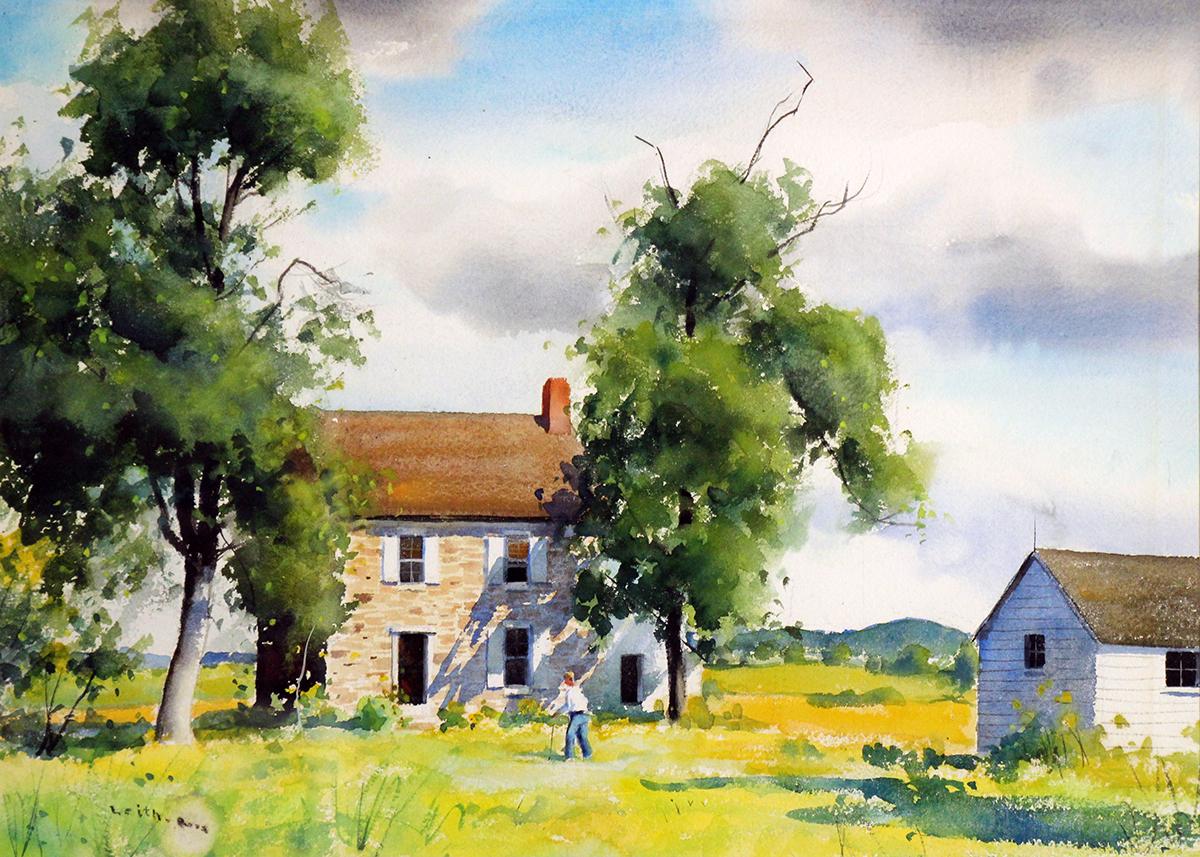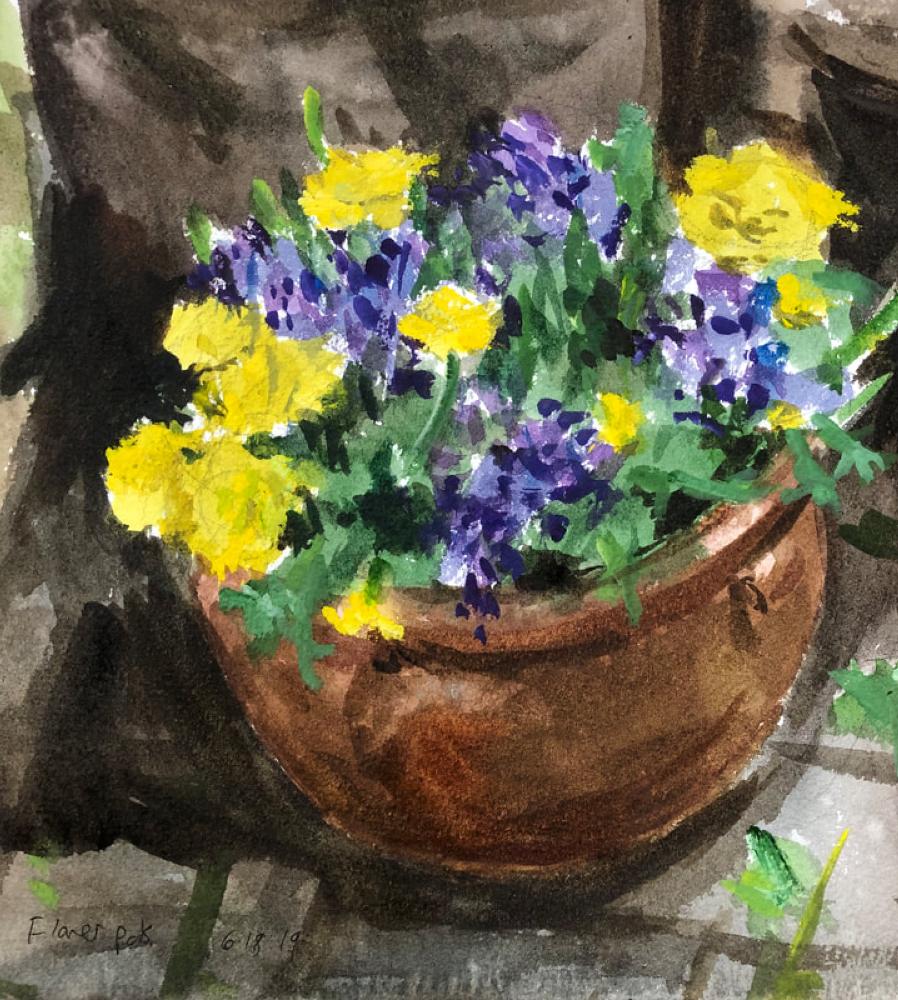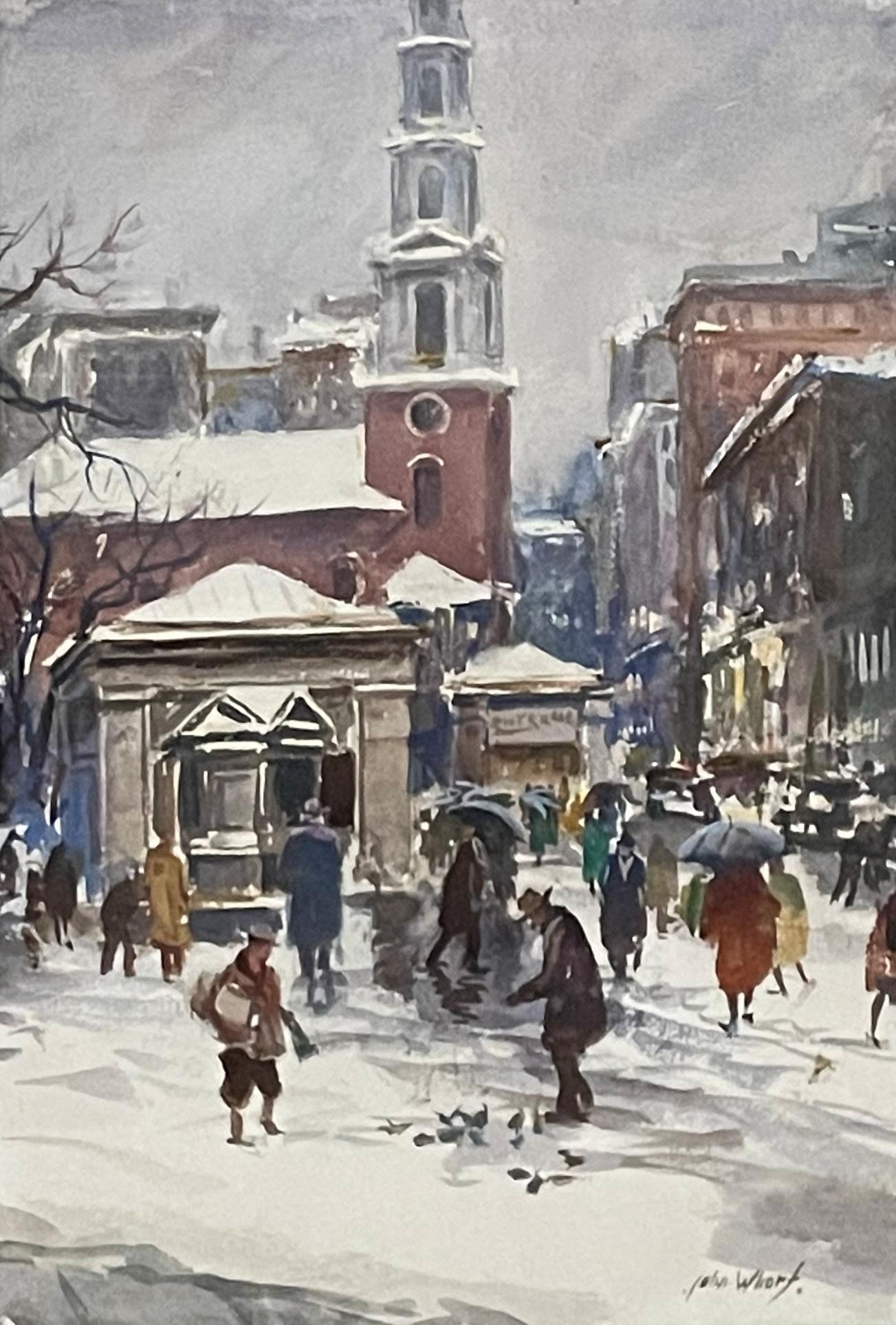Items Similar to Mid Century Mexico Cathedral Watercolor Landscape
Want more images or videos?
Request additional images or videos from the seller
1 of 9
Eugenia Frances Baker McComasMid Century Mexico Cathedral Watercolor Landscape 1945
1945
About the Item
Vibrant Mexico Cathedral by Eugenia Francis Baker McComas (American, 1886-1982). Presented in a wooden frame. Shipped without glass. Signed "Gene Frances" lower left. Image size, 15"H x 19"W.
Eugenia Frances Baker McComas was born in San Francisco, California on September 6, 1886. She came from a family of journalists where her father Joseph Eugene Baker was the editor of the Alta Californian, now San Francisco Examiner, and her mother was a theater critic for The Oakland Tribune.
Eugenia also known as “Gene” worked as a journalist for The Oakland Tribune for a period of time. She also studied at the California School of Arts and Crafts under artist Xavier Martinez. She met artist Francis McComas through her mentor Xavier Martinez, and married Francis in 1917 at the Palace Hotel in San Francisco and a day after their wedding, they moved to Monterey.
They settled on the Monterey Peninsula in Pebble Beach but continued to make trips to Europe, Mexico, Alaska, Hawaii, and the South Seas. Not wanting to compete with her husband’s landscapes, Gene painted flower and still life paintings though her greatest passions were her large mural paintings. She received her first solo show at Gumps in 1924, but her first successful show was at O’Toole Gallery in New York City in 1938, a year after the death of her husband. Throughout her life, she received various commissions for murals. Her last commission mural was executed in 1950 for the lobby of the Spreckles Sugar Company building. Although this building was destroyed, her mural was saved and is now the property of Monterey Peninsula Museum of Art. Towards the end of her life, Gene lost her eyesight but was able to attend a museum retrospective of her works in 1980. She died in Monterey, California on March 21, 1982. Gene McComas is well-known as a landscapist, although she also painted portraits and still lifes. A member of the Carmel Art Association, the San Francisco Art Association and the National Society of Mural Painters.
- Creator:Eugenia Frances Baker McComas (1886 - 1982)
- Creation Year:1945
- Dimensions:Height: 22 in (55.88 cm)Width: 26 in (66.04 cm)Depth: 1 in (2.54 cm)
- Medium:
- Movement & Style:
- Period:
- Condition:Shipped without glass. Vintage mat and frame.
- Gallery Location:Soquel, CA
- Reference Number:
About the Seller
5.0
Platinum Seller
These expertly vetted sellers are 1stDibs' most experienced sellers and are rated highest by our customers.
Established in 1986
1stDibs seller since 2014
2,506 sales on 1stDibs
Typical response time: <1 hour
- ShippingRetrieving quote...Ships From: Soquel, CA
- Return PolicyA return for this item may be initiated within 14 days of delivery.
More From This SellerView All
- 1930's California Watercolor Landscape -- "Palm Trees"By Margaret E. RogersLocated in Soquel, CAWonderful 1930s watercolor California landscape with iconic palm trees by Santa Cruz artist Margaret E. Rogers (American, 1872-1961). Titled "Palm Trees" and signed "Margaret Rogers" on verso. Presented in a wooden frame. Image, 14"H x 12"L. Born in Birmingham, England on May 1, 1872, the Rogers family immigrated to California in 1875 and established a prosperous sheep ranch in Monterey County. In her youth Margaret was known as one of the finest horsewomen in the West. The magazine Western Woman...Category
1930s American Impressionist Landscape Paintings
MaterialsWatercolor, Laid Paper
- Trout Gulch Road Design Proposal, Aptos CA - Watercolor on Heavy CardstockBy Jon BlanchetteLocated in Soquel, CABeautiful mid century watercolor of a design proposal for the village Fair Antiques "Apple Barn" in Aptos, California by listed artist Jon Blanchette (American, 1908-1987). Circa 1960 Signed "Jon Blanchette" lower right. Information about location and previous owner is on verso. Acquired with a collection of the artist's work. Art size: 9"H x 12"W Jon Blanchette was born in Somerset, England on March 29, 1908. He immigrated to Battle Creek, Michigan in 1918. Artistically inclined at age six, he later studied at the Pittsburgh Art...Category
Mid-20th Century American Impressionist Landscape Paintings
MaterialsWatercolor, Postcard, Permanent Marker
- San Diego Harbor at Night - Nocturnal Coastal Scene with US Navy ShipsLocated in Soquel, CASerene nocturnal seascape by George Fotherly Hargitt (American/Scottish, 1837-1926). The San Diego harbor stretches out in front of the viewer, depicted from a vantage point above th...Category
1920s American Impressionist Landscape Paintings
MaterialsWatercolor, Laid Paper, Gouache
- Shops in Aptos Village on Soquel Drive, Aptos, California - WatercolorBy Jon BlanchetteLocated in Soquel, CABeautiful mid century watercolor of stores in Aptos, California by listed artist Jon Blanchette (American, 1908-1987). Three stores sit side-by-side: a liquor store, a general store, and a pharmacy on the Old Aptos Village Boardwalk". They are brightly colored - green, yellow, and blue. In the background, there is a blue sky, green trees, and representations of the Aptos hills. Circa 1960 Signed "Jon Blanchette" lower right. Information about location and previous owner is on verso. Acquired with a collection of the artist's work. Art size: 9"H x 12"W Jon Blanchette was born in Somerset, England on March 29, 1908. He immigrated to Battle Creek, Michigan in 1918. Artistically inclined at age six, he later studied at the Pittsburgh Art...Category
Mid-20th Century American Impressionist Landscape Paintings
MaterialsPostcard, Watercolor, Permanent Marker
- Carriage Outside the St Charles Saloon - Columbia CA - Monochrome WatercolorLocated in Soquel, CADelicate watercolor of a carriage in front of two buildings by an unknown artist (20th Century). A carriage sits in front of two buildings, with bare trees framing the scene. This pi...Category
Late 20th Century American Impressionist Landscape Paintings
MaterialsWatercolor, Archival Paper
- Davenport, California SeascapeBy Edward PennimanLocated in Soquel, CAGorgeous large scale watercolor seascape of an ocean view in Davenport, California by Edward Penniman (American, b. 1942). Signed and dated "Edward G. Penniman 1991" and titled "Dave...Category
1990s American Impressionist Landscape Paintings
MaterialsWatercolor, Laid Paper
You May Also Like
- Homestead, Regional American Landscape by Pennsylvania ImpressionistBy Harry Leith-RossLocated in Doylestown, PA"Homestead" is a regional, American landscape by Pennsylvania Impressionist and New Hope School painter Harry Leith-Ross. The painting is a 14" x 19" watercolor on paper, signed "Lei...Category
1940s American Impressionist Figurative Paintings
MaterialsWatercolor, Archival Paper
- Blooming Flower Pots, Watercolor and Gouache over Pencil on White Paper, FramedLocated in Houston, TXBlooming Flower Pots is a Watercolor and Gouache over Pencil on White Paper .It is framed and ready to be shipped. One artists described Santoli's paintings as "Now that is a world class oil painting! Realistic casual brush work. The best I have seen. Delicious !! " Artist Statement: I simply love painting and my goal is to capture sunlight and color so that viewers can enjoy it as well. Eric...Category
2010s American Impressionist Still-life Paintings
MaterialsPaper, Watercolor
- "River Landscape" Julian Alden Weir, American Impressionist, Connecticut SceneBy Julian Alden WeirLocated in New York, NYJulian Alden Weir River Landscape Signed lower left Watercolor on paper 9 x 11 1/2 inches Provenance: Kraushaar Galleries, New York Sotheby's Parke Bernet, New York, 1965, Lot 27 E....Category
Late 19th Century American Impressionist Landscape Drawings and Watercolors
MaterialsWatercolor, Paper
- "Old Adobe Village, New Mexico" Alice Schille, Taos Pueblo, Female ImpressionistBy Alice SchilleLocated in New York, NYAlice Schille Old Adobe Village, New Mexico Signed lower right Watercolor on paper 5 x 6 inches Provenance: Estate of the artist Keny and Johnson Gallery, Columbus, Ohio Santa Fe East Galleries, Santa Fe, New Mexico Private Collection, California A painter in watercolor and oil, Alice Schille was a prolific artist using modernist styles of Post-Impressionism, Pointillism and Fauvism. Her subjects included portraits of women and children, landscapes with and without figures, a series of scenes of New York City. New Mexico, and Gloucester, Massachusetts. Her paintings also reflected her widespread international travels in Europe, North Africa, Russia, the Middle East, Mexico, and Guatemala. Although personally very shy, Schille possessed unusual courage and strength of will, which was reflected in both her independent lifestyle and in her work, as she continually worked to master new modes of painting throughout her career. A German critic once referred to Schille as "this daredevil disciple of art who is interested in anything and afraid of nothing." Alice Schille was born in Columbus, Ohio to a family supported by her father's success in manufacturing. She was raised in Columbus, and by the time she was age six, she determined to be an artist. She graduated at the top of her class from Central High School in 1887, studied from 1891 to 1893 at the Columbus Art School, and returned there as a teacher from 1902 to 1948. Going to New York City as a young woman, she enrolled in the Art Students League from 1897 to 1899 and then the New York School of Art with William Merritt Chase and Kenyon Cox. (Some years later, she attended Chase's Shinnecock Summer School on Long Island). From 1903 to 1904, Alice Schille was in Paris at the Academie Colarosi, and also studied privately with Raphael Collin, Rene Prinet, Gustave Courtois and Chase, who was then in Europe. In 1904, five of her paintings were accepted for exhibition at Societe Nationale des Beaux Arts, and from that time on her work was included regularly in important American annual exhibitions including the Pennsylvania Academy, the Corcoran Gallery, American Watercolor Society, Boston Art Club, and the 1987 inaugural exhibition of the National Museum of Women in the Arts in Washington DC. Between 1905 and 1914, Alice Schille painted in Europe, and during the summers of 1916 to 1918, worked in New York and Gloucester. In 1919, she was in New Mexico. On this trip, her first to the Southwest, she spent a summer in Taos and Santa Fe and painted scenes including the Taos Pueblo, Canyon Road and local Hispanic and Indian figures. Reportedly the Ranchos de Taos Church was one of her favorite subjects. Many of these New Mexico paintings were hung at annual exhibitions of the Philadelphia Water Color Club. Between 1920 and 1940, she traveled frequently in the summers, returning to New Mexico and going to Central America and Africa. In 1922, she began her first series of North-African watercolors...Category
1920s American Impressionist Landscape Drawings and Watercolors
MaterialsPaper, Watercolor
- "Park Street Church, Boston, " John Whorf Impressionist Watercolor WPA CityscapeBy John WhorfLocated in New York, NYJohn Whorf (1903 - 1959) Park Street Church, Boston, circa 1930-45 Watercolor on paper 21 x 15 inches Signed lower right Housed in its original frame Provenance: Milch Gallery, New ...Category
1930s American Impressionist Landscape Drawings and Watercolors
MaterialsWatercolor, Paper
- "Train Station, " Max Kuehne, Industrial City Scene, American ImpressionismBy Max KuehneLocated in New York, NYMax Kuehne (1880 - 1968) Train Station, circa 1910 Watercolor on paper 8 1/4 x 10 1/4 inches Signed lower right Provenance: Private Collection, Illinois Max Kuehne was born in Halle, Germany on November 7, 1880. During his adolescence the family immigrated to America and settled in Flushing, New York. As a young man, Max was active in rowing events, bicycle racing, swimming and sailing. After experimenting with various occupations, Kuehne decided to study art, which led him to William Merritt Chase's famous school in New York; he was trained by Chase himself, then by Kenneth Hayes Miller. Chase was at the peak of his career, and his portraits were especially in demand. Kuehne would have profited from Chase's invaluable lessons in technique, as well as his inspirational personality. Miller, only four years older than Kuehne, was another of the many artists to benefit from Chase's teachings. Even though Miller still would have been under the spell of Chase upon Kuehne's arrival, he was already experimenting with an aestheticism that went beyond Chase's realism and virtuosity of the brush. Later Miller developed a style dependent upon volumetric figures that recall Italian Renaissance prototypes. Kuehne moved from Miller to Robert Henri in 1909. Rockwell Kent, who also studied under Chase, Miller, and Henri, expressed what he felt were their respective contributions: "As Chase had taught us to use our eyes, and Henri to enlist our hearts, Miller called on us to use our heads." (Rockwell Kent, It's Me O Lord: The Autobiography of Rockwell Kent. New York: Dodd, Mead and Co., 1955, p. 83). Henri prompted Kuehne to search out the unvarnished realities of urban living; a notable portion of Henri's stylistic formula was incorporated into his work. Having received such a thorough foundation in art, Kuehne spent a year in Europe's major art museums to study techniques of the old masters. His son Richard named Ernest Lawson as one of Max Kuehne's European traveling companions. In 1911 Kuehne moved to New York where he maintained a studio and painted everyday scenes around him, using the rather Manet-like, dark palette of Henri. A trip to Gloucester during the following summer engendered a brighter palette. In the words of Gallatin (1924, p. 60), during that summer Kuehne "executed some of his most successful pictures, paintings full of sunlight . . . revealing the fact that he was becoming a colorist of considerable distinction." Kuehne was away in England the year of the Armory Show (1913), where he worked on powerful, painterly seascapes on the rocky shores of Cornwall. Possibly inspired by Henri - who had discovered Madrid in 1900 then took classes there in 1906, 1908 and 1912 - Kuehne visited Spain in 1914; in all, he would spend three years there, maintaining a studio in Granada. He developed his own impressionism and a greater simplicity while in Spain, under the influence of the brilliant Mediterranean light. George Bellows convinced Kuehne to spend the summer of 1919 in Rockport, Maine (near Camden). The influence of Bellows was more than casual; he would have intensified Kuehne's commitment to paint life "in the raw" around him. After another brief trip to Spain in 1920, Kuehne went to the other Rockport (Cape Ann, Massachusetts) where he was accepted as a member of the vigorous art colony, spearheaded by Aldro T. Hibbard. Rockport's picturesque ambiance fulfilled the needs of an artist-sailor: as a writer in the Gloucester Daily Times explained, "Max Kuehne came to Rockport to paint, but he stayed to sail." The 1920s was a boom decade for Cape Ann, as it was for the rest of the nation. Kuehne's studio in Rockport was formerly occupied by Jonas Lie. Kuehne spent the summer of 1923 in Paris, where in July, André Breton started a brawl as the curtain went up on a play by his rival Tristan Tzara; the event signified the demise of the Dada movement. Kuehne could not relate to this avant-garde art but was apparently influenced by more traditional painters — the Fauves, Nabis, and painters such as Bonnard. Gallatin perceived a looser handling and more brilliant color in the pictures Kuehne brought back to the States in the fall. In 1926, Kuehne won the First Honorable Mention at the Carnegie Institute, and he re-exhibited there, for example, in 1937 (Before the Wind). Besides painting, Kuehne did sculpture, decorative screens, and furniture work with carved and gilded molding. In addition, he designed and carved his own frames, and John Taylor Adams encouraged Kuehne to execute etchings. Through his talents in all these media he was able to survive the Depression, and during the 1940s and 1950s these activities almost eclipsed his easel painting. In later years, Kuehne's landscapes and still-lifes show the influence of Cézanne and Bonnard, and his style changed radically. Max Kuehne died in 1968. He exhibited his work at the National Academy of Design, the Art Institute of Chicago, the Carnegie Institute in Pittsburgh, the Memorial Art Gallery of the University of Rochester, and in various New York City galleries. Kuehne's works are in the following public collections: the Detroit Institute of Arts (Marine Headland), the Whitney Museum (Diamond Hill...Category
1910s American Impressionist Landscape Drawings and Watercolors
MaterialsPaper, Watercolor
Recently Viewed
View AllMore Ways To Browse
Mexican Midcentury
Mexico Midcentury
Cathedral Cathedral
Midcentury Wooden Art
Cathedral Art
Mexico Mid Century Art
Midcentury Art Mexico
From Cathedral
Arts And Crafts Landscape Art Paintings
1980 Landscape Painter
Vintage Cathedral
Landscape 19 Century
Cathedral Paintings
Cathedral Painting
Paintings Of Cathedrals
Palace Hotel
Hotel Mexico
Large Mid Century Landscape Painting




